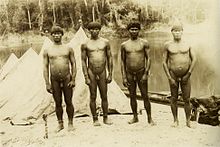Cultural differences in sexuality
| The accuracy of this content has been questioned. See the discussion for more information. |
| Resource type: this resource contains a tutorial or tutorial notes. |
Cultural differences in sexuality (15 mins)
[edit | edit source]You might want to preface this section by saying that if people find the discussion of sexual motivation uncomfortable, they should be free to leave. Warn them that some of the material you are about to present is quite graphic.
Read the snapshots of the following three societies and then lead a class discussion on how there are many areas in which people’s sexual behavior differs including culturally.
Janet Hyde (2003[1]) provides brief snapshots of three societies that vary in their patterns of sexual behavior. You might present them in class as an extension of the text discussion of sexual practices.
Based on the studies of cultural anthropologist John Cowan Messenger. [2] [3] [4] [5]
Based on the studies of anthropologist Donald S. Marshall. [6] [7]
 While the people of Inis Beag seem to have little sex and plenty of anxiety and those of Mangaia have plenty of sex and little anxiety, the citizens of Mehinaku, a central Brazilian village, seem to have plenty of both. Sex is fascinating, the culture is highly eroticized, and there is an openness with children about sexual matters. For example, children typically know the names of their parents’ many extramarital lovers. Men openly compete with each other for women’s sexual favors, often by bringing small gifts such as fish. At the same time, however, there is a high degree of gender segregation. If a woman enters a “man’s” house and views what is forbidden, she may be taken to the woods and gang-raped. In every other respect, the culture is nonviolent. Women are believed to have a much lower sex drive, there seems to be little recognition of female orgasm, and menstruation is understood to be dangerous. Dreams and fables speak to the culture’s sexual anxiety. In myths, those who engage in extramarital sex typically die in fantastic ways. Although people seem to experience intense ambivalence and anxiety over sexuality, they continue their interest and vigorous pursuit of the activity. |
References
[edit | edit source]- ↑ Hyde, J., & Delamater, J. D. (2003). Understanding human sexuality (8th ed.). New York: McGraw-Hill.
- ↑ Messenger, John C. Inis Beag: Isle of Ireland. Long Grove: IL: Waveland Press, 1983. ISBN 0-88133-051-5, OCLC 10578752
- ↑ John C. Messenger, "Sex and Repression in an Irish Folk Community", in Donald S. Marshall and Robert C. Suggs, eds., Human Sexual Behavior: Variations in the Ethnographic Spectrum, 1971. Basic Books, New York.
- ↑ John C. Messenger, Ines Beag Revisited: The Anthropologist as Observant Participator. Publisher: Salem, Wisconsin: Sheffield, 1989. ISBN 0-88133-408-1
- ↑ John Messenger, Peasants, Proverbs, and Projection. Central Issues in Anthropology April 1991, Vol. 9, No. 1: pp. 99–105 doi:10.1525/cia.1991.9.1.100
- ↑ Marshall, Donald S. Sexual behavior on Mangaia. Human sexual behavior (1971): 103-162.
- ↑ Harris, Helen. Rethinking Polynesian Heterosexual Relationships: A Case Study on Mangaia, Cook Islands in William Jankowiak ed Romantic Passion: A Universal Experience? (1997)
- ↑ Gregor, Thomas. The Mehinaku: The Dream of Daily Life in a Brazilian Indian Village. 2009
See also
[edit | edit source]- w:Inis Beag (a pseudonym for w:Inisheer, w:Ireland)
- w:Mangaia, w:Cook Islands
- w:Mehinako people


